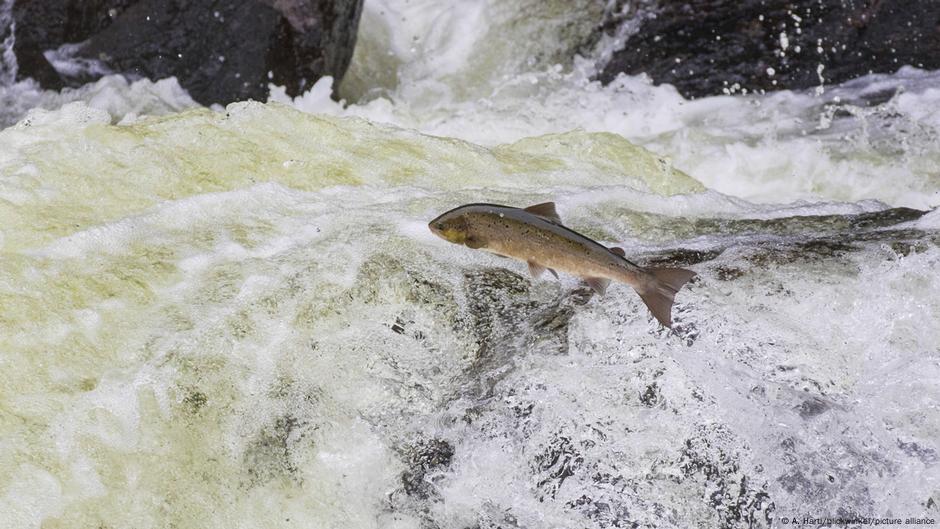- Reuters
- Yesterday
Psychoactive drug pollution makes fish less risk-averse
-

- DW
- Apr 11, 2025

WEB DESK: A common anti-anxiety drug, which has been found to pollute the world’s waterways, seems to be influencing the migration behaviour of wild Atlantic Salmon, according to a study out of Sweden.
The study, published in the journal Science, found that wild salmon became less risk-averse when they were exposed to the psychoactive drug clobazam. That, in turn, changed the way the fish migrate.
Read more: From extinction to existence: The dire wolf first howls in 12,500 years!
“[Salmon exposed to clobazam] were more likely to complete their migration to the sea, and they passed through man-made barriers like hydropower dams faster than fish that were not exposed,” said Jack Brand at the Swedish University of Agricultural Sciences in Uppsala, the study’s lead author.
“While an increase in migration success might initially sound like a positive effect, any disruption to natural behaviours can have negative consequences that ripple across ecosystems,” Brand told DW.
Surveys of the world’s rivers have found drug contamination in waterways on every continent on Earth — even Antarctica. Almost 1,000 different active pharmaceutical drugs have been detected in environments worldwide, harming biodiversity, ecosystem functioning and public health.
How drug pollution changes salmon migration
The researchers conducted large field studies and controlled laboratory experiments to study the effects of clobazam on salmon behaviors because the drug has been widely detected in the world’s waterways.
In field experiments, the researchers implanted a telemetry tracing device into 279 wild salmon, along with an implant which slowly released small amounts of clobazam.
They traced the salmon as they migrated down the River Dal in Sweden, passing through two hydropower dams and then into the Baltic Sea.
They found that a control group of salmon, that was not exposed to the clobazam, passed through the hydropower dams slower than the fish that were exposed to the drug.
“We suspect that these observed migration changes may stem from drug-induced shifts in social dynamics and increased risk-taking behaviour — effects that could be explained by the anti-anxiety nature of the drug,” said Brand.
How clobazam changes salmon behaviour
Lab experiments also found that clobazam changed the way the salmon moved in shoals. They created less tightly packed shoals, particularly in the presence of predators, which could heighten the risks they faced in the wild.
“Altered migration timing could cause fish to reach the sea under suboptimal conditions or increase their exposure to predators and other hazards. Over time, these subtle changes can alter population dynamics and even potentially disrupt ecosystem balance,” said Brand.
The study did not reveal any long-term effects of pharmaceutical pollution in waterways on salmon populations.
“The researchers followed the fish for the duration it took for them to migrate, which was roughly 10 days,” said Josefin Sundin, an ecologist at the Institute of Freshwater Research in Drottningholm, Sweden. Sundin was not involved in the study.
“We do not know if or how the smolt [young salmon] were affected during their continued life out in the Baltic Sea, or if there would be effects when they return to the river as adults to mate,” Sundin told DW.
How drugs pollute waterways elsewhere in the world
The study is the latest to highlight the ecological problem of pharmaceutical pollution.
Researchers have so far investigated the effects of over 400 different pharmaceutical compounds in almost 200 different species of aquatic animals.
Pharmaceuticals enter the environment via treated or untreated sewage water, and from discharge of livestock or veterinary wastewater effluents. The drugs accumulate in the bodies and brains of wild animals.
Experiments in Canada in 2006 found that fish populations were being exposed to a common synthetic estrogen used in birth-control pills. Accumulation of the hormone in wild fish led to the feminization of males and the near collapse of local fish populations.
“Many, but not all, of the studies found that the tested drug had an effect on animal behavior,” said Sundin.
Given the broad presence of pharmaceutical substances in waterways across the globe, Brand suspects that many different species may be vulnerable to their effects. Studies are showing that pharmaceuticals can move through the entire food chain.
“This can affect not just aquatic life but also land animals that feed on insects or fish from contaminated waterways, showing how far-reaching these effects might be,” said Brand.
How to reduce pharmaceutical pollution
Conventional water treatment methods are not always effective at removing pharmaceuticals, which is partly why traces of these compounds leak out into wild waters.
Some advanced wastewater treatment methods like new membrane filtration and oxidation processes have been successful in reducing pharmaceutical contamination.
However, they remain unavailable in many parts of the world due to insufficient infrastructure and associated costs. That’s why upgrading wastewater treatment systems is part of the solution, but it is not the only one, said Brand.
Scientists have highlighted the potential for “green chemistry” in reducing drug pollution. This involves designing drugs that biodegrade more quickly in the environment or become less toxic after use.
“On the policy side, stronger regulations and improved disposal practices can help to limit how much pharmaceutical pollution ends up in the water in the first place,” said Brand.
Read more: Punjab’s free medicine home delivery faces suspension
“No single fix will be enough, but by combining efforts across science, policy, and technology, we can reduce the risks pharmaceutical pollution poses to wildlife,” he added.




